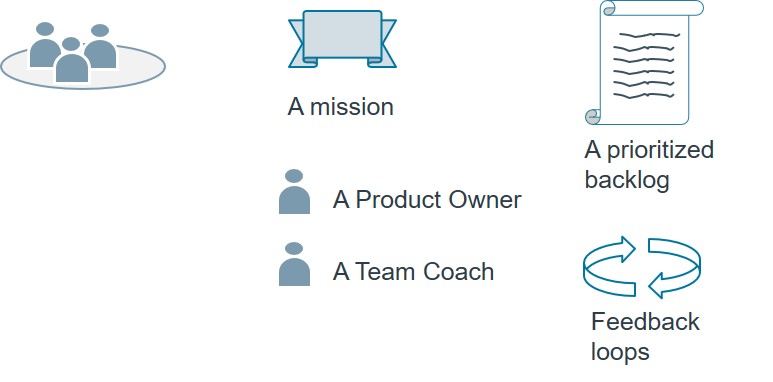3. Team based organisation

Why it matters
Organizing yourself around teams is standard practice in Agile software development.
Benefits of a team-based setup:
- Easier to adopt to changing requirements
- The team can self-organize and solve operational tasks
- More complex tasks can be given to such a unit
- Easier to train and onboard new members
- Easier for an individual member to learn new things, if one is so motivated
“Team morale is a significant benefit of Agile adoption, with 64% of organizations claiming morale improvements as a measured benefit. The other key benefits are the ability to manage changing requirements (69%), project visibility (65%), business/IT alignment (64%) and delivery speed (63%)” (13th Annual State of Agile Report, Collabnet Version One).
Working team-based also works well in functions outside IT, which has been demonstrated by case examples from Marketing, Business Operations, Business Development, Media & Content & Legal.
The flip side of choosing a team-based approach is that leaders need to invest and engage in building effective working teams. As a team becomes self-organizing, this pays back in the long run. That said, the competence required for building high performing teams needs to be built into the leadership structure.
How it works
Practice: Team setup

Setup conditions
- Organize in units between 5 – 10 people
- Each team is shaped based on its mission: “Why we are here?”.
Team setup artifacts

| Mission | This should contain an inspiring purpose for the team. The mission needs to be “handshaked” with the team members when the team is launched. This is a way to validate that the mission fulfills both being inspiring (for the members), and valuable (to the organization). Examples of team mission responsibilities can be solving a customer problem, running and evolving a service, building a service, building a system capability. |
| Prioritized backlog | Prioritize what the team takes on |
| Feedback loops | Feedback loops should allow the team to learn if it’s making progress towards its mission. |
| Role: Product owner | The product owner is responsible for prioritizing what the team takes on and for stakeholder management. |
| Role: Team coach | The team coach is responsible for building the team as a responsible high-performing team and for facilitating continuous improvement. |
While there exists more advanced patterns around the team setup, this list describes the essentials that through empirical practice have been found useful to bootstrap Agile teams in different functional domains.
What about the line manager?
A number of different patterns exist in how the line manager is engaged. The role the line manager takes on depends on the rate of change in the environment and the maturity level of the teams. The basic pattern is that the line manager is responsible for improving the environment where the team operates, which includes removing impediments, training and preparing, bootstrapping and dismantling teams, and resolving conflicts.
Principle: Bring work to people, instead of people to work
One of the differences in how to organize work in a team-based organization is how work flows. In a project-based setup, individuals are allocated to projects and people work in the project for a limited period. In a team-based setup, projects are first sliced based on value and smaller increments of value are fed to teams.
The basic idea is that teams that have reached the performing state are nurtured to stay in this state so that they can be better deployed to tackle increasingly complex tasks (a customer problem, a project, innovating something new). When the team tackles more complex tasks, a higher degree of ownership and increased morale usually follows.
The long term benefit is that it allows the organization to run improvements across projects. This in turn inhibits the buildup of technical debt while enabling a faster time to market.
Note: Here we are talking about how to organize work to meet common demand, not just one way to handle all types of demand. Special types of demand can be and should be handled differently.
The hidden benefit of adopting a team-based approach is that the organization learns to master a wider array of techniques in how to handle knowledge transfer and dependencies (beyond just moving individual co-workers to projects). This is supported by improved knowledge transfer between individuals in each team.
Download
- You can download the Team Essentials Bootstrap Template here.
References
“Team Based Learning Organization”, Wikipedia
“The two-pizza rule and the secret of Amazon’s success”, The Guardian, 2018
“13th Annual State of Agile Report”, Collabnet Version One, 2019
“Teams and performance: A proven link”, Deloitte Human Capital Trends, 2019
“The Scrum Guide”, Sutherland Jeff, Swaber Ken, 2020